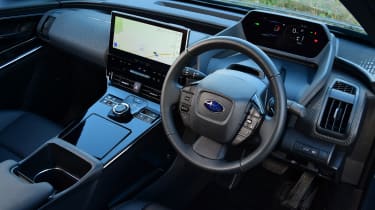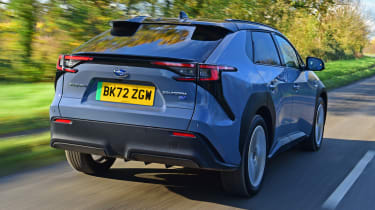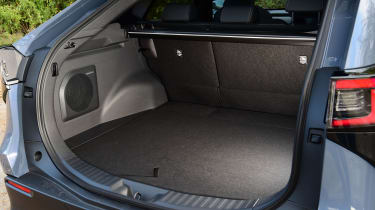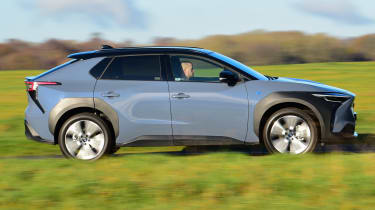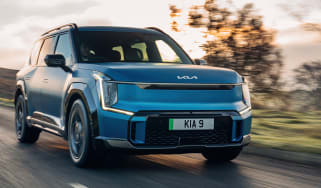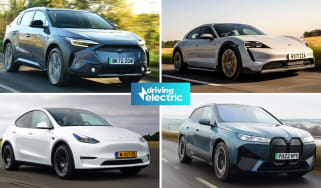Subaru Solterra review
Subaru’s first electric car is a well-rounded family SUV that’s good to drive, but doesn’t match the practicality or range of the best in this class
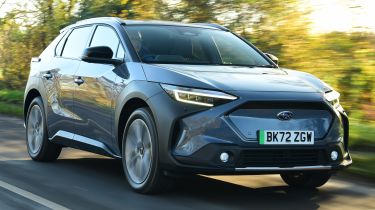
Pros
- All-wheel drive as standard
- Good to drive
- Infotainment and cabin
Cons
- Rivals offer more boot space
- Average range and charging speeds
- Not very efficient in winter
| Car type | Range | Wallbox charge time | Rapid charge time |
|---|---|---|---|
| Electric | 257-289 miles | 11hrs 30mins (0-100%, 7.4kW) | 28mins (10-80%, 150kW) |
It took Subaru a while to join the party, but the company is now one of the many car makers with an electric SUV in its range. You’d have been forgiven for experiencing some déjà vu when the Subaru Solterra first arrived in showrooms in July 2022, though. The Solterra is almost identical inside and out to the Toyota bZ4X electric family SUV, with the only major changes being visual touches like different badges, redesigned rear lights, a tweaked front grille panel and some black cladding around the wheel arches.
But as the brand likes to point out, this is not a bait-and-switch, badge-engineering job. Subaru helped to develop the two cars’ underpinnings (also being used by the Lexus RZ 450e) and their specific off-road settings. The X-Mode system controls the motors and brakes to deliver optimum traction on difficult terrain such as deep mud, snow or even steep, slippery slopes, according to Subaru.
The Solterra also distinguishes itself from the bZ4X by featuring permanent all-wheel drive as standard – as is the Subaru way – though it is an option on the Toyota and there are similar dual-motor versions of all this car's highly accomplished rivals, including the Tesla Model Y, Skoda Enyaq iV, Nissan Ariya, Ford Mustang Mach-E, Kia EV6 and Hyundai Ioniq 5, with plenty more waiting in the wings.
As well as all-wheel drive traction, the Solterra’s two electric motors produce a combined total of 215bhp and 337Nm of torque; enough for 0-62mph in a smidge under seven seconds. The 71.4kWh battery is the only size offered and good for 289 miles on a charge in base Limited-trim cars, while Touring-spec models like the one we drove only have a 257-mile range, likely as a result of the increased rolling resistance from their larger 20-inch wheels.
For context, entry-level versions of the Model Y, Mustang Mach-E and Enyaq iV offer between 246 and 283 miles of range, however, specific variants of all three can crack the 300-mile barrier with relative ease. The Solterra’s rapid charging capabilities don’t set it apart either, topping out at a relatively average 150kW. Filling up from 10-80% using a charging point capable of that speed will take around half an hour, while a 7.4kW home wallbox will need nearly 12 hours to fully replenish the battery.
The cabin is dominated by the huge 12.3-inch central touchscreen, and thankfully it’s great. The display itself is bright and clear, and the menus are well thought-out. It responds quickly to touches and loads quickly, too. All versions of the Solterra come with wireless Apple CarPlay, too, but you’ll need a cable to use Android Auto.
The seven-inch instrument panel on the other hand, while still clear and crisp, isn’t such a highlight. Like Peugeot’s similarly divisive i-Cockpit (see our sister site Carbuyer for an explainer) setup, the dials are mounted above the wheel, which doesn’t work for everyone. Shorter drivers, for example, might have the wheel blocking part of the screen – as we experienced first hand. Some useful EV info, such as remaining battery percentage, are also lacking, though a software update will address this in time, we’ve been told.
The Solterra bucks the trend of relying on touch-sensitive panels and sliders, instead sticking with buttons and physical controls for the most part, most noticeably on the steering wheel. The climate controls are a combination of physical and touch switches, and they’re reasonably easy to get along with. It’s certainly better than the setup’s we’ve tried that rely wholly on a car’s touchscreen, such as those in some Solterra rivals like the Volkswagen ID.4 and Skoda Enyaq.

The layout of the button-laden and high centre console ensures key functions are within reach, but it also prevents the cabin from feeling as airy or spacious as a Nissan Ariya or Hyundai Ioniq 5’s. We can't fault the quality though; the sturdy plastics and use of fabric materials over the dashboard help to make feel as premium as you might expect from an EV costing £50,000 or more.
Hop into the back of the Solterra, and you’re greeted with loads of kneeroom. Headroom is a little tight, but the rear seats can recline, which taller passengers might find handy. However the lack of leg support for them can’t be fixed as the high floor forces your thighs off the squab. At least passengers can keep their devices charged up with a pair of USB-C sockets.
The Solterra’s boot is a decent size (452 litres for entry-level Limited models; 441 litres in top-spec Touring versions), but significantly smaller than a Skoda Enyaq iV or Tesla Model Y’s. While you do get some under-floor storage in the Solterra (which gives you somewhere to keep the charging cables when you’re not using them), unlike some other electric cars, the Subaru doesn’t have a ‘frunk’ compartment under the bonnet.
You might not expect a two-tonne-plus electric SUV to be the sort of car we’d praise for its performance, but hats off to Subaru for finding a great middle ground achieved between capable handling and a settled ride with the Solterra. In terms of ride comfort, the car remains composed over bumps and does a solid job of cushioning passengers from shocks. The cabin is well isolated from road noise as well, making the Solterra a great motorway cruiser.
Come face-to-face with some corners and you’ll find body roll is kept to a minimum, while the Solterra’s steering is light enough to make manoeuvring around town easy, but it is still well weighted and provides an impression of feedback from the front tyres.
Power delivery is smooth from the pair of electric motors, and we have no reason to doubt the claimed 6.9-second 0-62mph time. Slowing down is just as impressive because the Subaru’s brake feel is reassuring, and the transition between the regeneration of the electric motor and physical brakes is almost imperceptible. The level of brake regeneration can be adjusted on the fly via paddles mounted behind the steering wheel, while the strongest setting – almost capable one-pedal driving, but doesn’t bring the car to a complete stop – is accessed via a button on the dashboard.
Sadly, the Solterra seemed to be hit harder by the cold, winter weather than we’d usually see. It achieved a rather disappointing figure of 2.5 miles per kilowatt hour, while a Skoda Enyaq we tested at the same time returned 3.0mi/kWh. At that rate, the Subaru could only cover 178 miles before the battery runs flat, compared to 231 miles in the Skoda. Of course, we’d expect the Subaru to be more efficient in the warmer months, but how much better? We’d need to test it again in order to find out.
When it comes to specifying a Solterra, Subaru has kept things very simple. Just two trim levels are available and there aren’t any optional extras beyond the paint finishes. Entry-level Limited spec starts from £52,495 and comes with 18-inch alloy wheels, a power tailgate, adaptive cruise control, heated front and rear seats and a heated steering wheel, that 360-degree parking camera, a digital rear-view mirror and a heat pump to more efficiently warm the battery. The car is also compatible with the ‘Subaru Car App’ that lets you check the amount of remaining charge, remotely lock the car and even find the car when parked.
Upgrading to Touring trim adds faux-leather upholstery, 20-inch alloy wheels, a panoramic sunroof, a Harman/Kardon sound system, wireless smartphone charging and an electric passenger seat. This spec does bring with it a reduced range, though, and at £55,495 it’s quite a bit more expensive than the entry-level Solterra, too.
Even in its most affordable guise, the Subaru Solterra can look pretty pricey against some of its main rivals. Entry-level versions of other electric family SUVs like the Nissan Ariya, Kia EV6 and Skoda Enyaq all undercut the Subaru by quite a hefty margin – and, if you don’t need the all-wheel drive system, a front-wheel drive Toyota bZ4X is cheaper like-for-like, too.
It might not be as quirky as Subarus of old, but the Japanese brand’s successes still come from a determination to do things differently to everyone else. In the case of the Solterra, that’s fitting all-wheel drive as standard and logical and easy to use controls, which are then combined with great on-board tech, performance and driving dynamics. However, it simply isn’t as practical or efficient as some of its key rivals, of which many are cheaper to buy.

